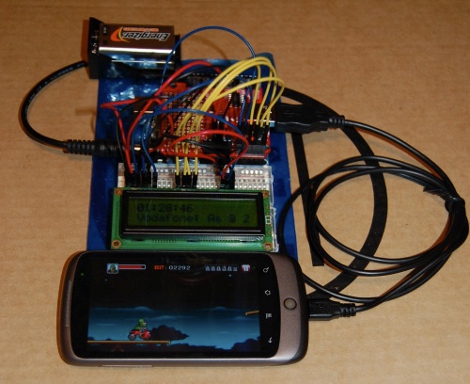
[follower] prototyped a 2-line external display for his Nexus One using an Arduino with a USB Host Shield, and the Android Open Accessory Protocol. There are two basic software pieces at work: an Arduino sketch that handles displaying data sent from the phone, and a lightweight android app to detect the presence of the external screen and send data to it. As shown here, it diplays the time and the beginning of the most recently received SMS message.
This project coalesced from several other things [follower] had been working on with regards to USB accessories, background services, interfacing with the Arduino and handling SMS messages, so it’s modular and open-source. If you’re interested in mashing up microcontroller projects and your android phone, there’s plenty of stuff in this project to help you get off the ground.
As hacks go, this is very much a “because you can” sort of deal that’s designed to tie a bunch of cool things together. You’re unlikely to catch us carrying an LCD and breadboard around in our pockets any time soon, but it paves the way for some potentially fun phone accessories.














Nice. Could be good to veiw sms/email/notifications etc without having to remove you phone from you pocket, via a watch or something, perfect for in a meeting or out jogging.
I’m pretty sure you can already get watches that do exactly that. I believe sony ericsson did it a couple of years ago, working via blutooth. Whilst as the article says this is a because you can hack, i can’t see any use for this commercially.
I’ve got the sony ericsson watch … two lines and vibration via bluetooth, bidirectional communications and everything you’d expect.
It took me 6 months to acquire one, the knockoff on thinkgeek didn’t live up to my standards.
google searching for mbw-150 xda android
will get you some nice imagery
This, in a nutshell, is what I don’t like seeing arduinos used for. Just my personal opinion. But while it was easy to make, it is now useless for practical purposes until it is entirely re-designed. Many microcontrollers can do this job in a much smaller package than an arduino shield, but it’s a whole new project.
Arduinos are great, but this is just impractical. Still, good for fun.